
views
- A thin, wispy cloud of white smoke from your exhaust may be caused by harmless condensation buildup. However, thick, persistent clouds indicate a more serious issue.
- Cracks in the head gasket allow fuel, oil, and coolant to leak into the combustion chamber, causing white smoke from your exhaust.
- Address white smoke by checking for coolant and oil leaks. Use a block leak test kit to identify any exhaust gases that may be present in the liquid.
Common Causes of White Smoke

Condensation buildup A common experience for car owners during cooler months is seeing a steady, thin white cloud of smoke when you start your car. It's usually present for 30 seconds to 1 minute before disappearing. This is a result of condensation buildup in the exhaust pipe. This is normal, and you don't need to take any precautions. However, if the smoke doesn't go away or is thicker than normal, you may want to have your car inspected. Danger Level: None.

Crack in the head gasket A vehicle's head gasket creates a seal between the head of each cylinder and the engine block, where fuel and air combine to power the engine. Fuel, oil, and coolant can leak into the combustion chamber without a functional head gasket and cause internal damage. These liquids will produce steam when leaked, causing white smoke in your exhaust. Additional signs of a bad head gasket include an overheating or inefficient engine. Danger Level: High. If you see thick clouds of white smoke, pull over and turn off the engine as soon as possible. You may need to replace your engine.

Broken engine block An engine block is also known as a cylinder block, which makes up the bottom end of a motor where pistons are fired. While they're built to last the lifetime of your vehicle, if you have a car with over 100,000 miles on it, you may begin to see signs of wear and tear, like a cracked cylinder, which can contribute to seeing white smoke. Danger Level: High. If left untreated, it may cause your engine to overheat and fail.
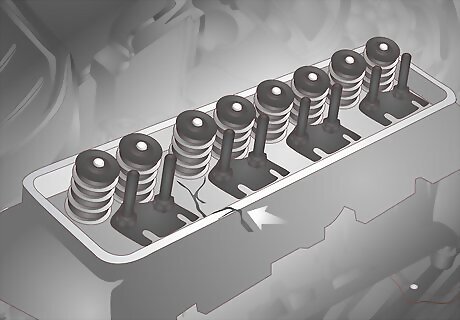
Crack in the cylinder head A vehicle's cylinder head is typically located on top of the engine block, which houses exhaust valves and the combustion chamber. One of its purposes is to channel your car's coolant into the engine. Still, coolant can leak into the combustion chambers when there's a crack before turning into water vapor. Danger Level: High. Continuous use of your vehicle can allow the crack to spread, overheating your car and making it unrepairable.

Faulty fuel injector A fuel injector is the heart of a car's engine. It delivers fuel to the engine, maximizing its power and keeping it running effectively. However, injectors are prone to leaks or can become stuck open. Too much liquid enters the combustion chamber when this happens, leaving behind thick white smoke. This is a common issue for diesel-powered vehicles where diesel is introduced to the cylinders at the wrong time or quantity. Danger Level: High. Driving with a faulty injector can cause misfires that damage the engine, release harmful emissions, and decrease vehicle safety.
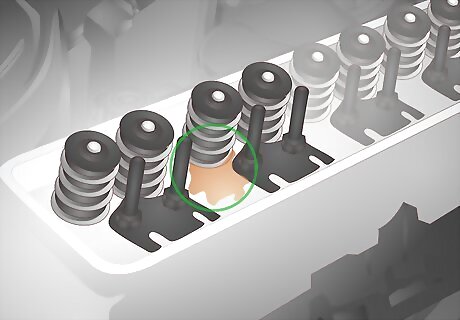
Leaking valve seal Valve seals control the amount of oil or coolant that enters the combustion chambers. Worn, cracked, or otherwise damaged valves can lead to excessive smoke. When left unaddressed, the smoke can change colors, signaling a larger and potentially more dangerous issue. Danger Level: Medium-High. Left unaddressed, leaking valve seals can cause engine damage.

Worn piston ring As with valve seals, your vehicle's piston rings can cause oil to drip into the combustion chamber. When mixed with other liquids, it can cause white smoke to come out of the exhaust. Danger Level: Medium-High. Avoid driving with bad piston rings for extended periods, as it can cause damage to your engine and increase the risk of an accident.

Damaged coolant reservoir tank The purpose of a coolant reservoir tank is to keep your engine's heat regulated. As the engine warms up, the coolant expands and overflows into the reservoir and then gets sucked back into the radiator as your car cools down. A crack or leak in the reservoir tank will require you to replenish the coolant constantly. If you don't, it may cause your engine to overheat and smoke. Danger Level: Low-Medium. While you can continue to drive with a damaged coolant reservoir, know that when you run out of coolant, your vehicle will not be able to cool itself. This may damage your engine, radiator, or thermostat over time.

Faulty engine control unit An engine control unit affects the fuel injection timing, which can cause white smoke. However, this doesn't mean both components are faulty. Danger Level: High. The engine control unit manages the engine’s performance. If this does not work, tow your car to the nearest mechanic.

Inadequate repairs Every now and then, mistakes happen. If you've had your car repaired recently, a botched job may contribute to seeing smoke come out of your exhaust. Even if the repair you got done seems unrelated, it may be worth investigating either through your mechanic, a reputable auto repair shop, or your dealership.
How to Fix White Smoke From the Exhaust

Inspect your coolant levels. First, park your car on leveled ground to check your coolant levels. For example, you won't get an accurate reading if you’re parked on a slated driveway. Open the radiator cap at the front of the engine; you should see coolant at the top. If not, that means the levels are too low. Check the overflow tank, too. It's usually a clear plastic container located near the radiator, with a tube that connects both components. On the side of the container, a mark should read "full." Be sure the coolant level reaches that line. What to do: Top off the coolant yourself if it looks low. If you don't feel comfortable doing that, take your vehicle to a mechanic for service. Potential cost: Coolant is typically inexpensive, costing less than $25 a gallon. However, a professional service may cost between $100 to $200.
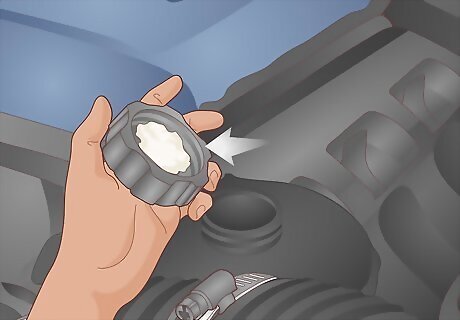
Check for a blown head gasket. A simple way to determine if your head gasket has failed is by removing the oil filler cap at the front of the engine. Be sure to keep the car off to avoid heating the engine. Look for milky brown goo beneath the cap. This indicates coolant has leaked into the oil, signaling a crack in the head gasket. You can also remove the radiator cap while the engine is cool. Allow it to run briefly so you can look for bubbles. What to do: As a temporary measure, clean the reservoir (attached to the bottom of the engine) and flush the radiator with water. Check your oil tank using the dipstick, too. If you see the oil-coolant mixture, change the oil. It’s best to get any leaks repaired by your mechanic. Potential cost: A temporary fix can cost up to $20. However, professionally repairing a head gasket can cost up to $3,000.
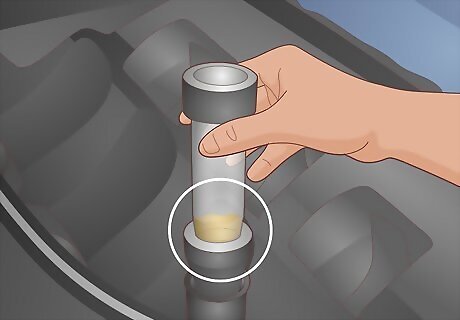
Perform a block leak test. Using a block leak detector kit, begin by draining a small amount of coolant from the radiator into a bucket or pan. Unplug the radiator cap and insert the test tube in the detector kit. Add enough test fluid until it reaches the test tube's fill line. Power on your engine. Use the hand pump several times to draw air into the radiator through the tester. What to do: If the test liquid turns yellow, exhaust gases are present in the liquid, and your head gasket is blown. As a temporary measure, you can use a coolant leak repair liquid to seal minor cracks. However, if the test liquid remains blue, schedule an appointment with your mechanic. Potential cost: Temporary fixes can cost up to $25, whereas replacing a blown head gasket costs between $1,000 to $3,000.

Replace the fuel pump after 2,485 miles (4,000 km). For diesel engines, a faulty fuel pump will make it difficult to start your vehicle. You may hear the engine stuttering or stalling or experience power surges in addition to white smoke. It's recommended you replace the fuel pump every 2,485 miles or 4,000 km to keep it running efficiently. What to do: Remove the existing fuel pump by pressing on the Schrader valve on the pressure line to capture the small fuel spray that comes out. You may need to ack your car to remove the fuel tank. Note all the fuel line connections and wiring before moving the old pump. Replace it with a new one. Potential cost: A DIY replacement can cost as low as $15 and as high as $2,000, depending on your vehicle. A professional fuel pump replacement can cost around $900 to $1,100.
Different Smoke Colors

Black Smoke If your vehicle is producing thick black smoke, this means the air and fuel ratio is too rich with fuel. This is often a result of a faulty fuel pressure regulator, a leaking fuel injector, or a faulty oxygen (O2) sensor. If this happens, your check engine light will appear on your dashboard. If this happens, bring your car to your mechanic or dealership to address the issue. Danger Level: Medium. If you catch the issue early on, these problems may not put your engine in immediate danger. However, it’s important to have any issues addressed early on to avoid further damage. Potential cost: Generally, a fuel pressure regulator can cost between $266 to $344. A fuel injector replacement costs up to $2,500, and a new oxygen sensor costs up to $500.
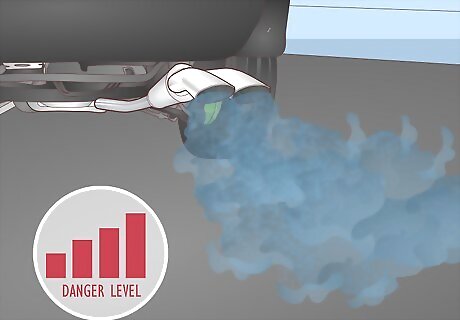
Blue Smoke Generally, blue or grey exhaust smoke indicates that your engine is burning oil. If this happens, your vehicle is likely leaking oil due to old or worn valve seals and piston rings. You may notice that you have to change your oil more often. Be sure to check the oil level using the dipstick and look for any debris that may be mixed in. Danger Level: High. This may be a sign that your engine is nearing the end of its lifespan and will need to be replaced or junked. Potential cost: Worn valve seal replacements can cost up to $250. Piston ring replacements can cost up to $3,500, depending on your vehicle’s model and engine type.


















Comments
0 comment